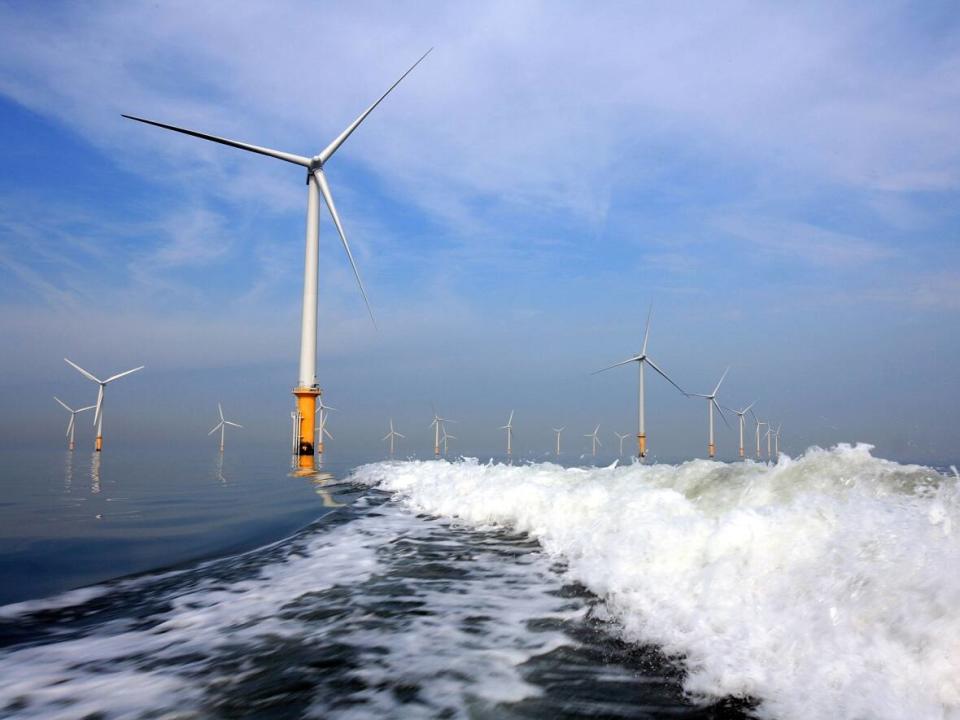Offshore wind farms could make Nova Scotia an 'energy-exporting region'

Natural gas platforms near Sable Island, N.S., were dismantled and removed years ago, but someday the shallow shelf in the North Atlantic could once again produce energy: renewable energy from offshore wind turbines.
Offshore wind is increasingly becoming part of a low-carbon future and, according to promoters in Halifax this week, Nova Scotia is an ideal location thanks to shallow seabed areas that can anchor offshore turbines and — of course — plenty of wind.
"The nice thing about Nova Scotia is that there's a lot of options. We have a lot of areas where you can get over 10 metres per second average wind speeds, which in a global context is spectacular," said Scott Urquhart, CEO and founder of Aegir Insights, based in Copenhagen.
Urquhart, a Cape Breton native, was one of the speakers at a marine renewable energy conference in Halifax this week. Working with Danish developers, he was part of the rapid increase in offshore wind farms in Europe.
He said costs there have dropped 70 per cent in the last decade, while the average project is expected to grow from 750 megawatts in 2025 to up to 3,000 megawatts by 2030. Nova Scotia Power has a capacity of 2,400 megawatts.
Cutting carbon
The opportunity here is not the domestic market, said Wendy Franks, an executive with Toronto-based Northland Power, a leading developer of offshore wind farms in Europe and Asia.
"If we could harvest the renewable energy and transform it into hydrogen, then the Maritimes could become an energy-exporting region," said Franks.
Electrons generated by turbines are fed through an electrolyzer with water, which separates hydrogen and oxygen molecules. Hydrogen can be stored and converted into "green ammonia" and used as zero carbon fuel.
"We're thinking about many different uses," said Franks.
"It could be something where we are exporting the ammonia by ships. It could be something also where actually the ships are consuming the hydrogen and using that to decarbonize their operations."
Offshore wind is likely coming to the east coast of North America with or without Nova Scotia.
Construction began this month on the first large offshore wind farm in the United States, the 800-megawatt, $3-billion, 62-turbine Vineyard Wind project off Cape Cod.
It will produce enough electricity to power 400,000 homes — about the size of the Nova Scotia Power residential customer base.
"We need so many more of these," said Massachusetts governor Charlie Baker at the Nov. 18 sod turning.
Vineyard Wind is the first but not the last big wind farm, he said.
"We now have [gigawatts] galore all the way up and down the Eastern Seaboard."
Need for clearer rules
The rules for offshore wind are not yet established in Canada, say promoters like Simon De Pietro, an Irish renewable energy developer also working on a tidal power project in Nova Scotia.
"Working in Atlantic Canada, Nova Scotia, what we're trying to say is, OK, what is the regulatory mechanism that we need to get seabed? What is that process?" he said.
Franks, of Northland Power, said she is heartened by conversations with "forward thinking" local regulators, but more clarity is needed.
"Clear regulation is very important. It doesn't exactly exist today."
Urquhart said the industry is waiting for encouragement from the government.
"People are looking to hear, what is the signal of the government? What's the signal for marine renewables in Canada?"
In a statement, the Nova Scotia Department of Energy and Mines said the government is committed to having 80 per cent of provincial electricity needs filled by renewable energy by 2030 and will entertain proposals for offshore wind.
"We are open to considering any and all proposals that offer affordable ways to increase our renewable energy use," spokesperson Patricia Jreige said.
Companies have been trying to harness electricity from the ocean for over a decade in Nova Scotia — but through tidal power in the Bay of Fundy.
Wind and tidal options
Jason Hayman of Sustainable Energy is one of those developers.
The company has just constructed an on-shore electrical substation to connect its floating tidal turbine platform on Digby Neck with the provincial grid.
He said offshore wind and tidal are complementary.
"We have developed anchoring and mooring technology for our tidal system that must endure very, very high loads. And we're getting a significant amount of interest now from the floating wind community about using that technology to moor floating wind turbines."
Like any offshore energy project, offshore wind development would likely trigger a fight with fisheries groups.
Vineyard Wind, in Massachusetts, is facing opposition from a coalition of commercial fisheries groups currently challenging the federal approval in court.
It shows that social licence is "a really big deal," said Franks.
"This includes a very careful, methodical evaluation of the environmental impacts. It means stakeholder engagement with the local communities, especially the fisheries, to make sure that we're being mindful of minimizing the impact to that important sector particularly here," she said.
"And then lastly, I would highlight because it's really important, is First Nations engagement in this."
MORE TOP STORIES

